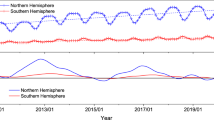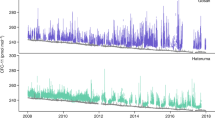Abstract
Methyl chloroform (CH3CCl3, 1,1,1,-trichloroethane) was used widely as a solvent before it was recognized to be an ozone-depleting substance and its phase-out was introduced under the Montreal Protocol1. Subsequently, its atmospheric concentration has declined steadily2,3,4 and recent European methyl chloroform consumption and emissions were estimated to be less than 0.1 gigagrams per year1,5. However, data from a short-term tropospheric measurement campaign (EXPORT) indicated that European methyl chloroform emissions could have been over 20 gigagrams in 2000 (ref. 6), almost doubling previously estimated global emissions1,4. Such enhanced emissions would significantly affect results from the CH3CC13 method of deriving global abundances of hydroxyl radicals (OH) (refs 7–12)—the dominant reactive atmospheric chemical for removing trace gases related to air pollution, ozone depletion and the greenhouse effect. Here we use long-term, high-frequency data from Mace Head, Ireland and Jungfraujoch, Switzerland, to infer European methyl chloroform emissions. We find that European emission estimates declined from about 60 gigagrams per year in the mid-1990s to 0.3–1.4 and 1.9–3.4 gigagrams per year in 2000–03, based on Mace Head and Jungfraujoch data, respectively. Our European methyl chloroform emission estimates are therefore higher than calculated from consumption data1,5, but are considerably lower than those derived from the EXPORT campaign in 2000 (ref. 6).
This is a preview of subscription content, access via your institution
Access options
Subscribe to this journal
Receive 51 print issues and online access
$199.00 per year
only $3.90 per issue
Buy this article
- Purchase on Springer Link
- Instant access to full article PDF
Prices may be subject to local taxes which are calculated during checkout


Similar content being viewed by others
References
McCulloch, A. & Midgley, P. M. The history of methyl chloroform emissions: 1951–2000. Atmos. Environ. 35, 5311–5319 (2001)
Prinn, R. G. et al. A history of chemically and radiatively important gases in air deduced from ALE/GAGE/AGAGE. J. Geophys. Res.—Atmos. 105, 17751–17792 (2000)
Montzka, S. A. et al. Present and future trends in the atmospheric burden of ozone-depleting halogens. Nature 398, 690–694 (1999)
Montzka, S. A. & Fraser, P. J. Scientific Assessment of Ozone Depletion 2002 Ch. 1.1–1.81 (WMO Global Ozone Research and Monitoring Project—Report No. 47, Geneva, 2003)
UNEP Production and Consumption of Ozone Depleting Substances under the Montreal Protocol, 1986–2000. (United Nations Environment Programme, Ozone Secretariat, Nairobi, 2002).
Krol, M. C. et al. Continuing emissions of methyl chloroform from Europe. Nature 421, 131–135 (2003)
Prinn, R. G. et al. Atmospheric trends and lifetime of CH3CCl3 and global OH concentrations. Science 269, 187–192 (1995)
Prinn, R. G. et al. Evidence for substantial variations of atmospheric hydroxyl radicals in the past two decades. Science 292, 1882–1888 (2001)
Montzka, S. A. et al. New observational constraints for atmospheric hydroxyl on global and hemispheric scales. Science 288, 500–503 (2000)
Spivakovsky, C. M. et al. Three-dimensional climatological distribution of tropospheric OH: Update and evaluation. J. Geophys. Res.—Atmos. 105, 8931–8980 (2000)
Krol, M., van Leeuwen, P. J. & Lelieveld, J. Global OH trend inferred from methylchloroform measurements. J. Geophys. Res.—Atmos. 103, 10697–10711 (1998)
Krol, M. & Lelieveld, J. Can the variability in tropospheric OH be deduced from measurements of 1,1,1-trichloroethane (methyl chloroform)? J. Geophys. Res.—Atmos. 108, 4125 (2003)
Gros, V. et al. Origin of anthropogenic hydrocarbons and halocarbons measured in the summertime european outflow (on Crete in 2001). Atmos. Chem. Phys. 3, 1223–1235 (2003)
Ryall, D. B., Derwent, R. G., Manning, A. J., Simmonds, P. G. & O'Doherty, S. Estimating source regions of European emissions of trace gases from observations at Mace Head. Atmos. Environ. 35, 2507–2523 (2001)
Manning, A. J., Ryall, D. B., Derwent, R. G., Simmonds, P. G. & O'Doherty, S. Estimating European emissions of ozone-depleting and greenhouse gases using observations and a modeling back-attribution technique. J. Geophys. Res.—Atmos. 108, 4405 (2003)
Vestreng, V. et al. Inventory Review 2004, Emission Data reported to CLRTAP and under the NEC Directive. (EMEP/EEA Joint Review Report, EMEP/MSC-W Note 1/2004, 2004).
Reimann, S. et al. Halogenated greenhouse gases at the Swiss High Alpine Site of Jungfraujoch (3580 m asl): Continuous measurements and their use for regional European source allocation. J. Geophys. Res.—Atmos. 109, D05307, doi:10.1029/2003JD003923 (2004)
Forrer, J. et al. Variability of trace gases at the high-Alpine site Jungfraujoch caused by meteorological transport processes. J. Geophys. Res.—Atmos. 105, 12241–12251 (2000)
Midgley, P. M. & McCulloch, A. The production and global distribution of emissions to the atmosphere of 1,1,1-trichloroethane (methyl chloroform). Atmos. Environ. 29, 1601–1608 (1995)
UNEP Report of the Fifteenth Meeting of the Parties to the Montreal Protocol on Substances that Deplete the Ozone Layer (United Nations Environment Programme, 2003).
O'Doherty, S. et al. In situ chloroform measurements at Advanced Global Atmospheric Gases Experiment atmospheric research stations from 1994 to 1998. J. Geophys. Res.—Atmos. 106, 20429–20444 (2001)
Cunnold, D. M. et al. In situ measurements of atmospheric methane at GAGE/AGAGE sites during 1985–2000 and resulting source inferences. J. Geophys. Res.—Atmos. 107, 4225 (2002)
Acknowledgements
We thank C. Harth and P. Salameh for calibration and data processing, G. Spain and D. Brown for instrument operation and maintenance at Mace Head and the Physics Department of NUI Galway for access to Mace Head facilities. Measurements and modelling at Mace Head are supported by NASA (USA) and DEFRA (UK). We thank SAEFL/BUWAL and BBW for financial support, HFSJG for access to Jungfraujoch facilities and P. Kaufmann (MeteoSwiss) for meteorological data. Both sites receive financial support from the EU 5th Framework Program (project SOGE).
Author information
Authors and Affiliations
Corresponding author
Ethics declarations
Competing interests
The authors declare that they have no competing financial interests.
Supplementary information
Supplementary Figure 1
This figure shows the comparison of measured CO time series at Mace Head in 2000 with modelled time series using NAME inversely estimated European emissions and EMEP emission estimates. (DOC 156 kb)
Supplementary Table 1
In this table best-fit estimated emissions of CH3CCl3 (three-year averages) from different European regions (Gg yr-1) by the NAME model are shown. (DOC 49 kb)
Supplementary Table 2
This table shows the decline of the world-wide regional emissions of CH3CCl3 between 1990 and 2000; calculated from consumption data. (DOC 37 kb)
Supplementary Table 3
In this table the comparison of regionalised European CH3CCl3 emission estimates, derived from the EXPORT campaign in 2000 and by the NAME inversion method from Mace Head (1999-2001) are shown. (DOC 35 kb)
Supplementary Table 4
This table shows excess concentrations of CO and CH3CCl3, which were used (together with the CO-emission estimates) for the calculation of the annual European emissions of CH3CCl3. (DOC 90 kb)
Rights and permissions
About this article
Cite this article
Reimann, S., Manning, A., Simmonds, P. et al. Low European methyl chloroform emissions inferred from long-term atmospheric measurements. Nature 433, 506–508 (2005). https://doi.org/10.1038/nature03220
Received:
Accepted:
Issue Date:
DOI: https://doi.org/10.1038/nature03220
This article is cited by
-
Background Characteristics of Atmospheric CO2 and the Potential Source Regions in the Pearl River Delta Region of China
Advances in Atmospheric Sciences (2020)
Comments
By submitting a comment you agree to abide by our Terms and Community Guidelines. If you find something abusive or that does not comply with our terms or guidelines please flag it as inappropriate.



